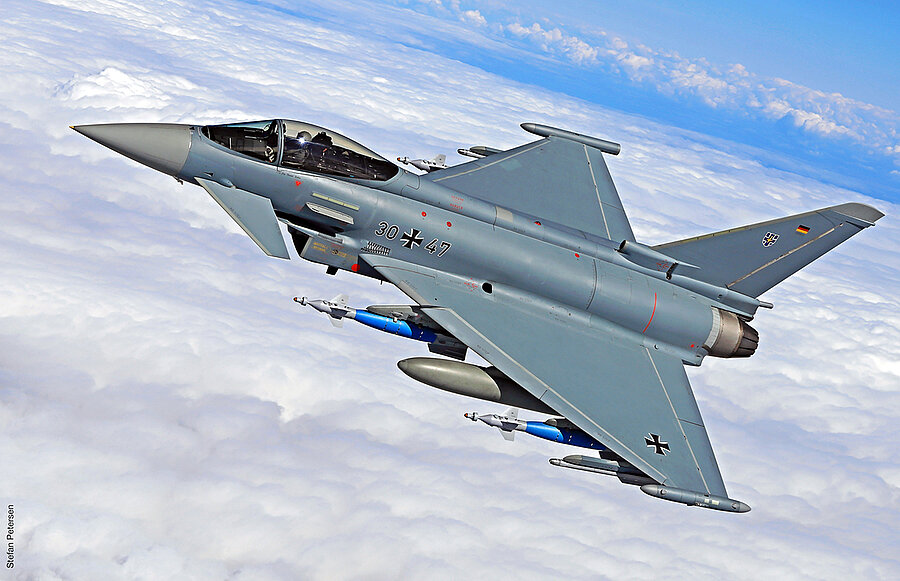European Sky Shield Initiative (ESSI)
Multi-layered defence
The European Sky Shield Initiative (ESSI) aims to ensure the future security of European air defence. 21 countries have already signed up to the initiative. With the TRML-4D and SPEXER 2000 3D MkIII radars, HENSOLDT already provides a significant part of the required radar technology. And the German sensor specialist has more technologies at its disposal that can further strengthen the capabilities of the upcoming defence shield.
September 20, 2024
info@hensoldt.net
CATEGORIES:
Radar
Surveillance
Ground-based radar
SPEXER, TRML
A challenge for Europe
Russia is using not only ‘traditional’ fighter aircraft and cruise missiles in its war of aggression on Ukraine but also drones, as well as ballistic and hypersonic missiles. Effective air defences have therefore become a topic of considerable importance in public discourse. During a speech in Prague in late August 2022, German Chancellor Olaf Scholz declared that Germany would invest heavily in its air defence capabilities.
At the same time, he invited European partners to engage in international collaboration. Almost six weeks later, in mid-October 2022, 15 nations signed a letter of intent to pursue the European Sky Shield Initiative. Another six nations have since joined the initiative. ESSI aims to strengthen European air defence by accelerating joint procurement. To ensure fast progress, the ESSI members intend to jointly procure, use and maintain the relevant systems.
Multiple interception layers
Figuratively speaking, air defence consists of multiple interception layers of different ranges that are superimposed, one on top of the other. Various military systems complement each other on account of their different interception levels – in other words, the different distances and altitudes in which the systems used operate. These include short and very short ranges (up to 6 km) as well as the medium and upper layers (up to and beyond 35 km). We can also make a distinction between ranges below and above 100 km.


Over the next few years, the system is to be replaced by the Nah- und Nahbereichschutz (LVS NNbS) air defence system. The development contract was awarded to ARGE NNbS, a consortium of the companies HENSOLDT, Rheinmetall and Diehl Defence.
The IRIS-T-SLM overall system covers the medium range. When it comes to long ranges, Germany and other nations use the US Patriot system (up to 100 km). From 2025, the Israeli Arrow 3 air defence system (over 100 km) will also be available to the German Armed Forces for very long ranges.
HENSOLDT´s radar contribution
The aforementioned IRIS-T-SLM is one of ESSI's flagship technologies and is an integral part of the initiative's medium-range defence. Alongside a Tactical Operations Centre and launchers for the guided missiles, the HENSOLDT TRML-4D radar is the most important component of the air defence missile system.
TRML-4D has already been reliably proving its detection capabilities against Russian attacks in Ukraine for two years. It is based on the latest AESA (Active Electronically Scanned Array) radar technology and guarantees the rapid detection and tracking of around 1,500 targets within a radius of up to 250 kilometres. It is capable of quickly and reliably recognising and tracking all types of air targets - cruise missiles, rockets, drones or aircraft - and classifying them for engagement.
Another HENSOLDT radar in the Skyshield initiative is SPEXER 2000, which can reliably detect threats at close and near range and is one of the leading radars for defence against unmanned aerial vehicles. The SPEXER 2000 3D MkIII variant will now become part of the new Skyranger anti-aircraft gun armour. Contracts for the first procurements have already been signed.
A major operational advantage of this radar is the high quality of target classification and the ability to precisely track targets while travelling or in flight.
Significant opportunities
HENSOLDT's Twinvis could also make a valuable contribution to ESSI. The passive radar does not transmit itself, but instead locates targets by analysing reflected signals from existing external transmitters. This ‘passive’ technology generates great added value in the field of air defence, especially in combination with TRML-4D - called TwinSens.
TwinSens provides an aerial image that is initially created without RF transmissions and therefore without the risk of enemy detection. The TRML-4D does not transmit during this time and therefore cannot be detected. Initial successes were achieved at a meeting of international armed forces on the use of passive reconnaissance technologies in autumn 2024, followed by further positive measurement campaigns in summer 2024.
ESSI is an important initiative for closing the capability gaps in Europe’s air defences. However, further effort is needed to ensure the success of the initiative.
There is still a long way to go until then, but HENSOLDT is ready to make its contribution.


